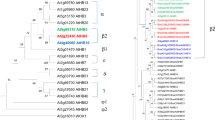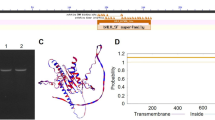Abstract
The occurrence of very-low-fluence responses (VLFR), low-fluence responses (LFR) and high-irradiance responses (HIR) of phytochrome was investigated for the expression of the gene of β-glucuronidase (gusA) under the control of the tobacco Lhcb1*2 promoter, in etiolated transgenic tobacco seedlings. The activity of β-glucuronidase (GUS) showed biphasic responses to the calculated proportion of Pfr provided by light pulses. The first phase (i.e. the VLFR) showed a maximum for Pfr levels characteristic of far-red light. The second phase (i.e. the LFR) was observed at higher Pfr levels and was reversible by far-red light pulses. The strong effect of continuous far-red light (i.e. HIR) was fluence-rate-dependent and could not be replaced either by hourly pulses of the same spectral composition and total fluence or by very low fluences of red light. Deletion Lhcb1*2 promoter to -453 caused little loss of GUS activity. The -453 to -31, -270 to -31 and -176 to -31 fragments of the Lhcb1*2 promoter conferred proportionally normal VLFR, LFR and HIR to a truncated (-46 to +8) CaMV 35S minimal promoter. This is the first demonstration of the presence of three phytochrome action modes in the control of the transcriptional activity of a single gene. The cis-acting regulatory elements necessary for VLFR, LFR and HIR are present in a 146 bp fragment of the tobacco Lhcb1*2 promoter.
Similar content being viewed by others
References
Anderson SL, Kay SA: Functional dissection of circadian clock-and phytochrome-regulated transcription of the Arabidopsis cab 2 gene. Proc Natl Acad Sci USA 92: 1500–1504 (1995).
Anderson SL, Teakle GR, Martino-Catt SJ, Kay SA: Circadian clock-and phytochrome-regulated transcription is conferred by a 78 bp cis-acting domain of the Arabidopsis cab 2 promoter. Plant J 6: 457–470 (1994).
Botto JF, Sánchez RA, Casal JJ: Role of phytochrome B in the induction of seed germination by light in Arabidopsis thaliana J. Plant Physiol 146: 307–312 (1995).
Botto JF, Sánchez RA, Whitelam GC, Casal JJ: Phytochrome A mediates the promotion of seed germination by very low fluences of light and canopy shade light in Arabidopsis. Plant Physiol 110: 439–444 (1996).
Carre IA, Kay SA: Multiple DNA-protein complexes at a circadian-regulated promoter element. Plant Cell 7: 2039–2051 (1995).
Casal JJ: Coupling of phytochrome B to the control of hypocotyl growth in Arabidopsis. Planta 196: 23–29 (1995).
Casal JJ, Clough RC, Vierstra RD: High-irradiance responses induced by far-red light in grass seedlings of the wild type or overexpressing phytochrome A. Planta 200: 132–137 (1996).
Casal JJ, Sánchez RA, Di Benedetto AH, De Miguel LC: Light promotion of seed germination in Datura ferox is mediated by a highly stable pool of phytochrome. Photochem Photobiol 53: 249–254 (1991).
Casal JJ, Sánchez RA, Vierstra RD: Avena phytochrome A overexpressed in transgenic tobacco seedlings differentially affects red/far-red reversible and very-low-fluence responses (cotyledon unfolding) during de-etiolation. Planta 192: 306–309 (1994).
Castresana C, Garcia-Luque I, Alonso E, Malik VS, Cashmore AR: Both positive and negative regulatory elements mediate expression of a photoregulated Cab gene from Nicotiana plumbaginifolia. EMBO J 7: 1929–36 (1988).
Castresana C, Staneloni RJ, Malik VS, Cashmore AR: Molecular characterization of two clusters of genes encoding the Type I CAB polypeptides of PSII in Nicotiana plumbaginifolia. Plant Mol Biol 10: 117–126 (1987).
Clough RC, Casal JJ, Jordan ET, Christou P. Vierstra RD: Expression of functional oat phytochrome A in transgenic rice. Plant Physiol 109: 1039–1045 (1995).
Degenhardt J, Tobin EM: A DNA binding activity for one of two closely defined phytochrome regulatory elements in an Lhcb promoter is more abundant in etiolated than in green plants. Plant Cell 8: 31–41 (1996).
Dehesh K, Franci C, Parks BM, Seeley KA, Short TW, Tepperman JM, Quail PH: Arabidopsis HY8 locus encodes phytochrome A. Plant Cell 5: 1081–1088 (1993).
Ditta G, Stanfield S, Corbin D, Helinski DR: Broad host range DNA cloning system for gram-negative bacteria: Construction of a gene bank of Rhizobium meliloti. Proc Natl Acad Sci USA 77: 7347-7351 (1980).
Ehmann B, Ocker B, Schäfer E: Development-and light-dependent regulation of the expression of two different chalcone synthase transcripts in mustard cotyledons. Planta 183: 416–422 (1991).
Fejes E, Pay A, Kanevsky L, Szell M, Adam E, Kay S, Nagy F: A 268 bp upstream sequence mediates the circadian clock-regulated transcription of the wheat Cab-1 gene in transgenic plants. Plant Mol Biol 15: 921–32 (1990).
Gidoni D, Bond-Nutter D, Brosio P, Jones J, Bedbrook J, Dunsmuir P: Coordinated expression between two photosynthetic petunia genes in transgenic plants. Mol Gen Genet 211: 507–514 (1988).
Gidoni D, Brosio P, Bond-Nutter D, Bedbrook J, Dunsmuir P: Novel cis-acting elements in Petunia Cab gene promoters. Mol Gen Genet 215: 337–344 (1989).
Gilmartin PM, Sarokin L, Memelink J, Chua NH: Molecular light switches for plant genes. Plant Cell 2: 369–378 (1990).
Hecht U, Mohr H: Relationship between phytochrome photo-conversion and response. Photochem. Photobiol. 51: 369–373 (1990).
Heim B, Schäfer E: Light-controlled inhibition of hypocotyl growth in Sinapis alba L. seedlings. Fluence rate dependence of hourly light pulses and continuous irradiation. Planta 154: 150–155 (1982).
Heim B, Schäfer E: The effect of red and far-red light in the high irradiance reaction of phytochrome (hypocotyl growth in dark-grown Sinapis alba L.) Plant Cell Environ 7: 39–44 (1984).
Hennikoff S: Unidirectional digestion with exonuclease III in DNA sequence analysis. Meth Enzymol 155: 156–165 (1987).
Hoekeme A, Hirsch PR, Hooykaas PJJ, Schilperoot RA: Abinary vector strategy based on separation of Vir-and T-region of the Agrobacterium tumefaciens Ti-plasmid. Nature 303: 179–181 (1983).
Horsch RB, Fry JE, Hoffman NL, Eichholtz D, Rogers SG, Fraley RT: A simple and general method for transferring gene into plants. Science 227: 1229–1231 (1985).
Horwitz BA, Thompson WF, Briggs WR: Phytochrome regulation of greening in Pisum. Chlorophyll accumulation and abundance of mRNA for light harvesting chlorophyll a/b binding proteins. Plant Physiol 86: 299–305 (1988).
Jefferson RA: Assaying chimeric genes in plants: The GUS gene fusion system. Plant Mol Biol Rep 5: 387–405 (1987).
Jefferson RA, Kavanagh TA, Bevan M: GUS fusions: β-glucuronidase as a sensitive and versatile gene fusion marker in higher plants. EMBO J 6: 3901–3907 (1987).
Johnson CB, Tasker R: A scheme to account quantitatively for the action of phytochrome in etiolated and light-grown plants. Plant Cell Environ 2: 259–265 (1979)
Kaufman LS, Thompson WF, Briggs WR: Different red light requirements for phytochrome-induced accumulation of cab RNA and rbcS RNA. Science 226: 1447–1449 (1984).
Kehoe DM, Degenhardt J, Winicov Y, Tobin EM: Two 10 bp regions are critical for phytochrome regulation of a Lemna gibba Lhcb gene promoter. Plant Cell 6: 1123–1134 (1994).
Kelly JM, Lagarias JC: Photochemistry of the 14-kilodalton Avena phytochrome under constant illumination in vitro. Biochemistry 24: 6003–6010 (1985).
Kendrick RE, Kronenberg GHM: Photomorphogenesis in plants. Kluwer Academic Publishers, Dordrecht (1994).
Kenigsbuch D, Tobin EM: Aregion of the Arabidopis Lhcb1* 3 promoter that binds to CA-1 activity is essential for high expression and phytochrome regulation. Plant Physiol 108: 1023–1027 (1995).
López-Juez E, Nagatani A, Tomizawa K-I, Deak M, Kern R, Kendrick RE, Furuya M: The cucumber long hypocotyl mutant lacks a light-stable PHYB-like phytochrome. Plant Cell 4: 241–251 (1992) 255
Lowry OH, Rosebrough NJ, Farr AL, Randall RJ: Protein measurement with the Folin phenol reagent. J Biol Chem 193: 265–275 (1951).
Mancinelli AL: The physiology of phytochrome action. In: Kendrick RE, Kronenberg GHM (eds) Photomorphogenesis in Plants, pp. 211–270. Kluwer Academic Publishers, Dordrecht (1994).
McCormac AC, Wagner D, Boylan MT, Quail PH, Smith H, Whitelam GC: Photoresponses of transgenic Arabidopsis seedlings expressing introduced phytochrome B-encoding cDNAs: evidence that phytochrome A and phytochrome B have distinct photoregulatory functions. Plant J 4: 19–27 (1993).
Mitra A, Choi HK, An G: Structural and functional analysis of Arabidopsis thaliana chlorophyll a/b binding protein (cab) promoters. Plant Mol Biol (1989).
Mösinger E, Batschauer A, Apel K, Schäfer E, Briggs WR: Phytochrome regulation of greening in barley. Effects on mRNA abundance and on transcriptional activity of isolated nuclei. Plant Physiol 86: 706–710 (1988).
Murashige T, Skoog F: A revised medium for rapid growth and bioassays with tobacco tissue cultures. Physiol Plant 15: 473-497 (1962).
Nagatani A, Chory J, Furuya M: Phytochrome B is not detectable in the hy3 mutant of Arabidopsis, which is deficient in responding to end-of-day far-red light treatments. Plant Cell Physiol 32: 1119–1122 (1991).
Nagatani A, Reed JW, Chory J: Isolation and initial characterization of Arabidopsis mutants that are deficient in Phytochrome A. Plant Physiol 102: 269–277 (1993).
Nagy F, Boutry M, Hsu MY, Wong M, Chua NH: The 50-proximal region of the wheat cab-1 gene contains a 268-bp enhancer-like sequence for phytochrome response. EMBO J 6: 2537–2542 (1987).
Pepper A, Delaney T, Washburn T, Poole D, Chory J: DET1, a negative regulator of light-mediated development and gene expression in Arabidopsis, encodes a novel nuclear-localized protein. Cell 78: 109–116 (1994).
Piechulla B, Kellmann JW, Pichevsky E, Schwartz E, Forster HH: Determination of steady state mRNA levels of individual chlorophyll a/b binding protein genes of the tomato cab gene family. Mol Gen Genet 230: 413–442 (1991).
Quail PH, Boylan MT, Parks BM, Short TW, Xu Y, Wagner D: Phytochromes: photosensory perception and signal transduction. Science 268: 675–680 (1995).
Sambrook J, Fritsch EF, Maniatis T: Molecular Cloning: A Laboratory Manual, 2nd edi. Cold Spring Harbor Laboratory Press, Cold Spring Harbor, NY (1989).
Schindler U, Cashmore AR: Photoregulated gene expression may involve ubiquitous DNA binding proteins. EMBO J 9: 3415–3427 (1990).
Schmidt S, Drumm-Herrel H, Oelmüller R, Mohr H: Time course of competence in phytochrome-controlled appearance of nuclear-encoded plastidic proteins and messenger RNAs. Planta 170: 400–407 (1987).
Sun L, Doxsee RA, Harel E, Tobin EM: CA-1, a novel phosphoprotein, interacts whith the promoter of the cab140 gene in Arabidopsis and is undetectable in det1 mutant seedlings. Plant Cell 5: 109–121 (1993).
Terzaghi WB, Cashmore AR: Light-regulated transcription. Annu Rev Plant Physiol Plant Mol Biol 46: 445–474 (1995).
Thompson WF, White MJ: Physiological and molecular studies of light-regulated nuclear genes in higher plants. Annu Rev Plant Physiol Plant Mol Biol 42: 423–446 (1991).
Van Tuinen A, Kerckhoffs LHJ, Nagatani A, Kendrick RE, Koorneef M: Far-red light-insensitive, phytochrome A-deficient mutants of tomato. Mol Gen Genet 246: 133–141 (1995).
Wei N, Chamovitz DA, Deng X-W: Arabidopsis COP9 is a component of a novel signaling complex mediating light control of development. Cell 78: 117–124 (1994).
White MJ, Kaufman LS, Horwitz BA, Briggs WR, Thompson WF: Individual members of the Cab gene family differ widely in fluence response. Plant Physiol 107: 161–165 (1995).
Whitelam GC, Johnson E, Peng J, Carol P, Anderson ML, Cowl JS, Harberd NP: Phytochrome A null mutants of Arabidopsis display a wild-type phenotype in white light. Plant Cell 5: 757–768 (1993).
Yoshida K, Takimoto A, Sasaki Y: Fluence-response relationship for photogene expression in etiolated pea seedlings. Photochem Photobiol 50: 121–124 (1989).
Zhong HH, Young JC, Pease EA, Hangarter RP, McClung CR: Interactions between light and the circadian clock in the regulation of CAT2 expression in Arabidopsis. Plant Physiol 104: 889–898 (1994).
Author information
Authors and Affiliations
Rights and permissions
About this article
Cite this article
Cerdán, P.D., Staneloni, R.J., Casal, J.J. et al. A 146 bp fragment of the tobacco Lhcb1*2 promoter confers very-low-fluence, low-fluence and high-irradiance responses of phytochrome to a minimal CaMV 35S promoter. Plant Mol Biol 33, 245–255 (1997). https://doi.org/10.1023/A:1005784407282
Issue Date:
DOI: https://doi.org/10.1023/A:1005784407282




